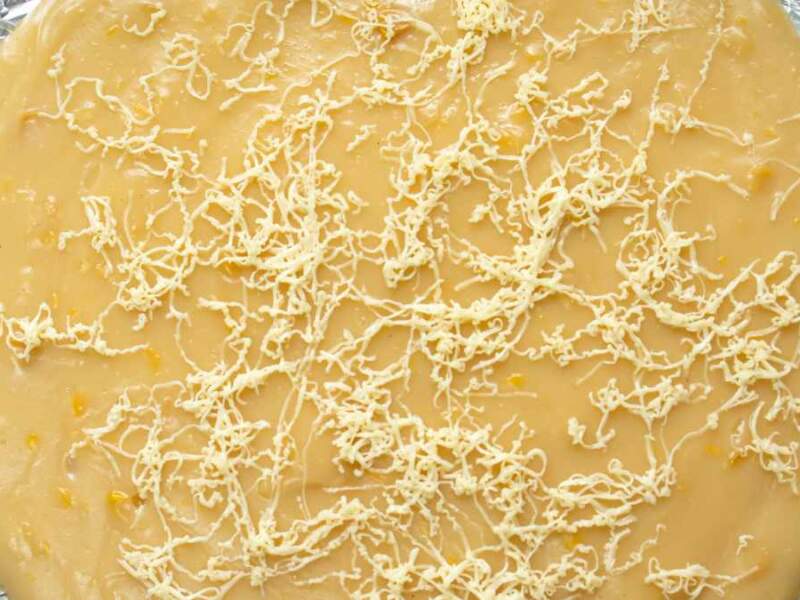Hello sweet parents! April here with relaxlangmom.com, bringing you easy dessert recipes from my tropical island home.
Today I’m sharing yema cake, a meltingly soft butter cake topped with silky yema custard for a rich and buttery Filipino treat.
Yema cake gets its name from the yema topping, a sweet custard made with egg yolks, that distinguishes it. Yema is a dense, pudding-like Filipino dessert made by cooking egg yolks with sugar and condensed milk.
The yema topping contrasts beautifully with the light, fluffy cake underneath. While the cake is airy and springy, the yema is rich and thick with a dense, custard-like texture.
For yema cake, you first bake a light sponge cake such as chiffon or yellow cake.
The key is balancing the cake batter so it comes out tender yet sturdy enough to support the yema custard. I start by creaming egg whites and sugar until light and fluffy. Then fold this into the cake mix carefully. Stir gently with a spatula to just barely combine. Do not overmix. You want to keep as much air in the batter as possible. Cut down through the center of the egg whites and lift the spatula up and over as you slowly turn the bowl a quarter turn.
Once the cake batter is combined, pour into the prepared pan and bake until a toothpick inserted comes out clean. While the cake bakes and cools, you make the yema topping by whisking egg yolks with sugar and condensed milk then cooking over low heat until thickened.
To assemble, place one layer of the cooled cake on a plate. Spread a thick layer of warm yema over the cake, allowing some to sink in. If you’re making a 2 layer cake, place the second layer on top and spread the remaining yema over the top and sides.
Then top with grated cheese like cheddar or Parmesan into the yema for a salty-sweet twist or sprinkling cheese on top of the yema.
The yema topping is what sets yema cake apart, giving it a unique flavor profile that balances sweet cake with denser custard. While the cake itself is similar to a caramel cake, the yema adds rich flavor and a creamier texture.
Here is the recipe!

Ingredients
Cake:
- 1 1/4 cups flour
- 1 teaspoon baking powder
- 1/2 teaspoon salt
- 1/4 cup sugar
- 2 tablespoons oil
- 4 egg yolks
- 1/3 cup water
- 4 egg whites
- 1/2 teaspoon cream of tartar (COT)
- 1/2 cup sugar
Frosting:
- 4 pieces egg yolks
- ½ cup evaporated milk
- 1 cup condensed milk
- ½ cup all-purpose cream
- 1 teaspoon vanilla extract (optional)
- 1 teaspoon lemon/ calamansi juice
- 2 tablespoons unsalted butter
- cheddar cheese grated
Instructions
- Preheat oven to 350°F and grease cake pan or aluminum pan (if for selling)
- In a bowl combine flour, oil, water, egg yolks, salt, and baking powder until smooth.
- In a separate bowl whip the egg whites with cream of tartar. Slowly add the sugar and beat until stiff peaks form. Gently fold into batter.
- Pour batter into pans and bake for 20-25 minutes, until a toothpick inserted comes out clean. Cool completely.
- For frosting, combine egg yolks, evaporated milk, condensed milk, cream, (vanilla), and lemon juice in a saucepan. Cook over low heat, stirring constantly until thickened (about 10 minutes). Remove from heat and stir in butter.
- Place one cake layer on a plate or aluminum pan. Top with frosting and allow to run in sides. Sprinkle with grated melting cheese after baking.
This yema-topped butter cake is deceptively simple but delivers big on flavor. The moist cake soaks up the caramel-like notes of the topping, intensifying the buttery sweetness in every moist bite.
Some Yema Cake tips:
•Bake the cake as directed and allow it to cool completely before topping.
•Combine egg yolks, sugar and evaporated milk for the yema custard over low heat, stirring constantly until thickened.
•Spoon the warm yema custard over the cake and enjoy every buttery-sweet bite!
I hope this rich but easy Filipino dessert brings back sweet memories and moments of joy with your little ones. To get my full yema cake recipe emailed to you along with recipe and craft ideas, simply sign up for my newsletter below!
Common Mistakes When Folding Mixture into a Cake
Here are some common mistakes people make when folding a mixture into a cake:
• Overmixing – This is the most common mistake. People mix too vigorously and lose too much of the air that’s been incorporated into the batter through whipping eggs or creaming butter and sugar. Overmixing leads to a dense cake.
• Not folding thoroughly enough – If the folded mixture like egg whites is not thoroughly incorporated into the batter, it can sink to the bottom of the pan and result in a heavy, uneven cake. The goal is to fold until just combined, not fully mixed.
• Using a spoon instead of a spatula – A spoon can really crush the batter and lose air. Use a wide, flexible spatula for gentle folding.
• Folding in one direction – Make sure to cut down through the center of the mixture and fold over itself in a turning motion. Folding in one direction only will not effectively combine the mixtures.
• Adding all the dry ingredients at once – If the dry ingredients like flour are added all at once, it can coat the wet ingredients and prevent proper mixing. It’s best to add half the flour, stir to combine, then add the remaining flour.
• Not letting the batter rest – Some batters, especially those with bread flour, benefit from a 10-15 minute rest after mixing to allow the gluten to relax. This results in a lighter, less dense cake.
April
relaxlangmom.com


